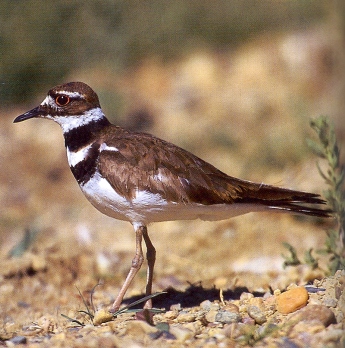|
Large
banded plover, brown upperparts and white underparts, two distinct
black bands cross upper breast. White stripes on wings are visible
in flight.
Tail and rump show rust-brown in flight. Black bill, pink-brown legs
and feet. Wavering, erratic flight, capable of swift, direct flight.

|
KILLDEER
Charadrius vociferus
CHARADRIIFORMES
Plovers (Charadriidae)
Range and Habitat
Breeds from Alaska east to Newfoundland and southward. Spends winters
north to British Columbia, Utah, the Ohio Valley, and Massachusetts;
also found in South America. Preferred habitats include open areas such
as plowed fields, golf courses, and short-grass prairies.
SOUND: "kill-dee", "kill-deear",
"kill-deeah-dee-dee"
Killdeer exhibit a clever "broken wing display"
in which they appear to be struggling with a broken wing while leading
the predator away from their babies.
Although technically shorebirds, they are unusual in this group because
they often nest and live far from water.
They are ground-nesting birds that are famous for hiding their nests
right out in the open. They really use no nesting materials and rely
on distraction displays to protect their offspring.
A group of killdeers are collectively known as a
"season" of killdeers.
The Killdeer is rated as Least Concern. The previous rating for the
Killdeer was Lower Risk. That rating was downgraded in 2004 to Least
Concern due to the stability of the range and population of this bird
species. This bird species is native to South America and the Caribbean.
The range of the Killdeer is large, reaching up to 14 million kilometers.
The population of the Killdeer is about 1 million individuals at this
time.
There are not any known threats facing the range or the population of
the Killdeer presently.

|